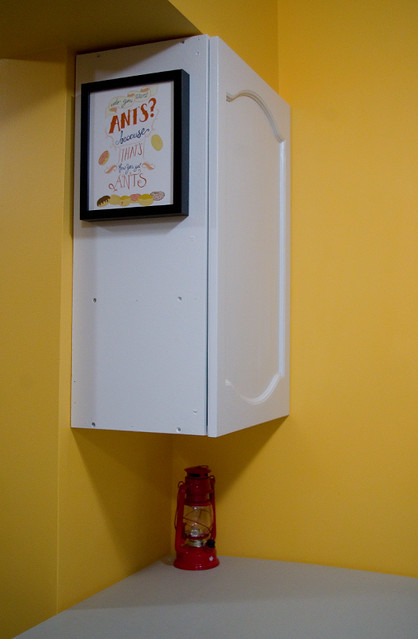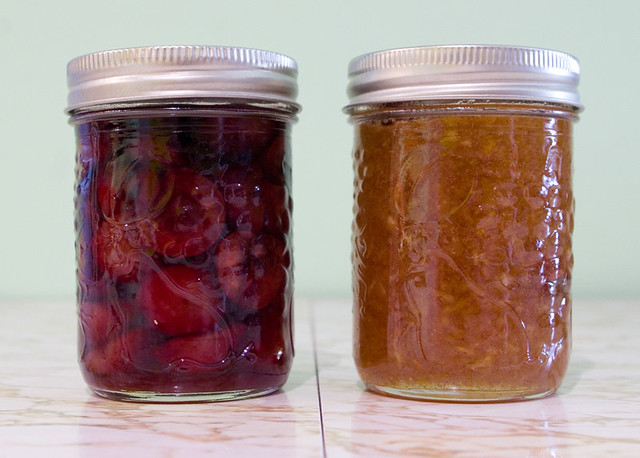A while back a friend of mine offered to let me pick crab apples from trees just outside of her back yard, on land that is owned by her community association. She has been picking apples from those trees for years in order to make crab apple jelly, as have a number of other neighbours who are inclined to make preserves. These totally wild, untended trees produce an overabundance of fruit every year, and the canners in the neighbourhood only make a tiny dent in that. I’d never made jelly before, but I figured sure, why not? I love cooking with ingredients that I can harvest locally, especially when that harvest is free!

The first thing that I realized is that making jelly is a lot more difficult than making jam. After washing all the tiny little apples and making sure to remove all leaves and stems, you have to cut them all in half. Sometimes the fruit can be wormy or rotten inside even though the outside is pristine, and cutting it in half means that you can check every single one. Then you have to cook the fruit, strain it through a jelly bag (being careful not to squeeze the bag so that the jelly will remain clear), boil the resulting juice along with sugar and any additional ingredients until set, and then finally can it.
After all that work, I was really happy that I liked the end result. Crab apple jelly is packed with tart flavour, even with all of the added sugar. I’m definitely going to make more next year. I’ll be sure to pick twice or even three times as much fruit. It’s not like the neighbourhood wildlife will miss the relatively small quantities that I will use.

One of the things that I was surprised about regarding crab apple jelly is how many of my preserving cookbooks don’t have a recipe for it. Not only that, but some of them don’t even consider crab apples to be a fruit worth canning. I find that odd because a) they’re very tasty, b) they are winter hardy in northern climes, and can even grow wild, and c) they’re often planted in orchards among the larger apple trees because it helps with pollination. They’re also a very popular ornamental tree, so it’s not like crab apples are hard to come by, either. The books that I have that included a crab apple jelly recipe are, in no particular order:
– Joy of Cooking page 932, or on the app (Irma S. Rombauer, Marion Rombauer Becker & Ethan Becker, 2006 edition)
– Pickles & Preserves page 58 (Love Food, 2012)
– The Complete Preserving Book page 92 (Canadian Living, 2012)
– The Good Cook: Preserving page 94 (Time-Life Books, 1981)
– Preserving page 166 (Oded Schwartz, 1996)
Although there are many variations when it comes to additional ingredients such as lemon juice, lime juice, or in one case hot peppers, all of the recipes seem to agree on a ratio of 1:1 of volume of strained juice to white sugar.
As an aside, if you’re interested in harvesting unused fruit from local sources and aren’t up to approaching homeowners/tenants on your own (although if you’re shy, a politely-worded letter is often well-received), you could volunteer for an organization here in Ottawa called Hidden Harvest. The group harvests fruits and nuts that would otherwise go to waste on public and private property. When the bounty is harvested, one quarter goes to the homeowner, one quarter goes to the volunteer harvesters, one quarter goes to the nearest food agency, and one quarter goes to Hidden Harvest. The portion kept by Hidden Harvest goes to their sponsors, who in turn help pay to run the organization. Last year alone the group harvested almost 4,500lbs of fruit and nuts, and donated almost 2,000lbs of that to charity.
In my case, I’m a homeowner whose apple tree drops hundreds of pounds of fruit every year, and I’d love to be able to have Hidden Harvest come and take most of the fruit away. I don’t need nearly so much. However, I’ll have to deal with that poor tree’s apple scab first. And my poor little pear tree‘s harvest of four pears this year isn’t worth volunteering. Perhaps when it grows a little bigger. Next year I’m seriously considering becoming a volunteer harvester, though. As for this year, I understand that apples with apple scab can actually make a better hard cider, so if any cider-makers want to clean the rest of the apples off of my tree, they’re welcome to them.
Maybe one of these days I should just buy/make a cider press.
























